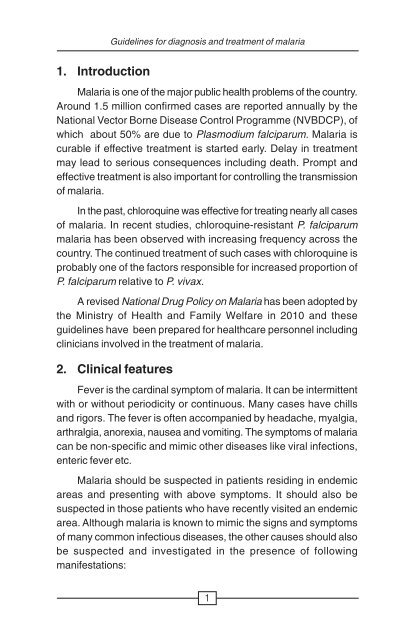Guidelines for Diagnosis & Treatment of Malaria in India - NVBDCP
Guidelines for Diagnosis & Treatment of Malaria in India - NVBDCP
Guidelines for Diagnosis & Treatment of Malaria in India - NVBDCP
Create successful ePaper yourself
Turn your PDF publications into a flip-book with our unique Google optimized e-Paper software.
<strong>Guidel<strong>in</strong>es</strong> <strong>for</strong> diagnosis and treatment <strong>of</strong> malaria<br />
1. Introduction<br />
<strong>Malaria</strong> is one <strong>of</strong> the major public health problems <strong>of</strong> the country.<br />
Around 1.5 million confirmed cases are reported annually by the<br />
National Vector Borne Disease Control Programme (<strong>NVBDCP</strong>), <strong>of</strong><br />
which about 50% are due to Plasmodium falciparum. <strong>Malaria</strong> is<br />
curable if effective treatment is started early. Delay <strong>in</strong> treatment<br />
may lead to serious consequences <strong>in</strong>clud<strong>in</strong>g death. Prompt and<br />
effective treatment is also important <strong>for</strong> controll<strong>in</strong>g the transmission<br />
<strong>of</strong> malaria.<br />
In the past, chloroqu<strong>in</strong>e was effective <strong>for</strong> treat<strong>in</strong>g nearly all cases<br />
<strong>of</strong> malaria. In recent studies, chloroqu<strong>in</strong>e-resistant P. falciparum<br />
malaria has been observed with <strong>in</strong>creas<strong>in</strong>g frequency across the<br />
country. The cont<strong>in</strong>ued treatment <strong>of</strong> such cases with chloroqu<strong>in</strong>e is<br />
probably one <strong>of</strong> the factors responsible <strong>for</strong> <strong>in</strong>creased proportion <strong>of</strong><br />
P. falciparum relative to P. vivax.<br />
A revised National Drug Policy on <strong>Malaria</strong> has been adopted by<br />
the M<strong>in</strong>istry <strong>of</strong> Health and Family Welfare <strong>in</strong> 2010 and these<br />
guidel<strong>in</strong>es have been prepared <strong>for</strong> healthcare personnel <strong>in</strong>clud<strong>in</strong>g<br />
cl<strong>in</strong>icians <strong>in</strong>volved <strong>in</strong> the treatment <strong>of</strong> malaria.<br />
2. Cl<strong>in</strong>ical features<br />
Fever is the card<strong>in</strong>al symptom <strong>of</strong> malaria. It can be <strong>in</strong>termittent<br />
with or without periodicity or cont<strong>in</strong>uous. Many cases have chills<br />
and rigors. The fever is <strong>of</strong>ten accompanied by headache, myalgia,<br />
arthralgia, anorexia, nausea and vomit<strong>in</strong>g. The symptoms <strong>of</strong> malaria<br />
can be non-specific and mimic other diseases like viral <strong>in</strong>fections,<br />
enteric fever etc.<br />
<strong>Malaria</strong> should be suspected <strong>in</strong> patients resid<strong>in</strong>g <strong>in</strong> endemic<br />
areas and present<strong>in</strong>g with above symptoms. It should also be<br />
suspected <strong>in</strong> those patients who have recently visited an endemic<br />
area. Although malaria is known to mimic the signs and symptoms<br />
<strong>of</strong> many common <strong>in</strong>fectious diseases, the other causes should also<br />
be suspected and <strong>in</strong>vestigated <strong>in</strong> the presence <strong>of</strong> follow<strong>in</strong>g<br />
manifestations:<br />
1

















